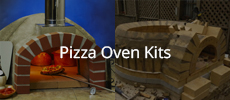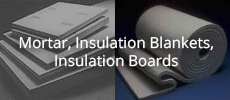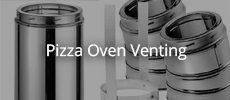With the last two ovens I have built, I have made the gallery from insulating fire brick.
By doing so the dome can not lose heat through that area and can therefor be sealed with a single door, however before I realised the benefits of a low mass gallery I was building high mass galleries, cast formed from a single casting.
I found that while the high mass gallery was easy to install, even when thermal breaks were fitted like stove rope, they had limited effect and the heat from the dome and floor was still traveling into the gallery walls that were in turn exposed to the air causing considerable heat lose.
So for next oven I built, I used a chimney fitted with a butterfly damper, with the damper closed and an inner and outer door in place I noted a massive improvement in heat retention!.
So I have now told my previous customers with the high mass galleries, that they can improve heat retention by keeping any heat loss from the dome, locked into the gallery by blocking off the chimney exit.
This is very simple if you have an insulated chimney it just needs an insulated cap placed over the top.
So from my own experience I have found that by by using two doors and a sealed, caped, chimney can dramatically enhance how long the dome can store heat.
Obviously if an oven is ‘not’ losing heat through the gallery walls or fire brick floor, then it would be pointless sealing the chimney or using an outer door for heat retention purposes …..
However, many if not most, pre cast or modular pizza ovens don't allow for thermal breaks as the gallery is cast into the design.
I built a very well insulated oven last year with an insulated gallery (featured elsewhere on the forum) even though it has a quite low mass of 275gk it takes four days to go from max temp back to ambient temperature.
Announcement
Collapse
No announcement yet.
Heat retention versus oven size
Collapse
X
-
My steel door was frequently around 90 to 110 degrees in the morning after a fire. I made a plywood outer door that fits snug in my vent arch and kind of butts against the semi-reveal created by the rear of my serpentine opening, so it inhibits free exchange of air from both the oven opening and the chimney. Was not even thinking about blocking off air from above, just wanted the wood door to sit as close to the metal door as possible. The large wooden handles on the inner door project almost to the start of the serpentine vent. Inner door is much hotter with outer door in place frequently sitting around 140 degrees F! Not sure if this would change if I only plugged the opening from the front, but what I have seems to be working well. To the points above, I have a gasket I have not installed in my door yet as I have been too lazy to clean all the creosote off the lip, but all these little things ha vesome impact on heat retention and without a good set of "before and after" data captured at both similar internal and external temperatures it's hard to say exactly what those impacts are.
- Likes 1
Leave a comment:
-
I'm not sure who uses a "piece of string" for a thermal break, but carry on. I'm trying to have a meaningful discussion about someone using chimney plugs. To each their own, as the saying goes. I'm all for saving all the heat we can. Naturally, if you or someone else feels the need, have at it. My main point still stands, though. If someone feels the need to do so, I really hope they took all the other measures during construction to save every last bit of generated heat, that's all. If not, using a plug is like fartin' in the wind.Originally posted by fox View PostLike I have already said it depend on the heat loss though the gallery and if the gallery is made from a heat sink martial.
If you can feel the inside of the gallery is still warm one hour after you have fitted the inner door then there will be a continuous heat loss, or if the floor bricks continue out past the inner door you will have a heat sink there too.
From my experience a thermal break has to be a bit more that a piece of string to work effectively so you either seal in the gallery with a outer door and chimney plug or apply a very effective heat break to prevent any of the dome heat traveling into the gallery section.
The door its self can often get very hot on the outside unless it is very well designed.
Of course none of that might not matter to the majority of wood oven owners but, this thread is about heat retention .
- Likes 1
Leave a comment:
-
Like I have already said it depend on the heat loss though the gallery and if the gallery is made from a heat sink martial.
If you can feel the inside of the gallery is still warm one hour after you have fitted the inner door then there will be a continuous heat loss, or if the floor bricks continue out past the inner door you will have a heat sink there too.
From my experience a thermal break has to be a bit more that a piece of string to work effectively so you either seal in the gallery with a outer door and chimney plug or apply a very effective heat break to prevent any of the dome heat traveling into the gallery section.
The door its self can often get very hot on the outside unless it is very well designed.
Of course none of that might not matter to the majority of wood oven owners but, this thread is about heat retention .
- Likes 1
Leave a comment:
-
Sorry guys. I still see no need whatsoever for a "chimney plug". Sealing up the doorway is great. Closing off a chimney at that point just makes no sense to me. If you're concerned w/losing heat to a flue gallery, you use thermal breaks and of course, a well sealed door. Now, if a chimney is built over the oven chamber, then it might make a difference, but a chimney shouldn't be there. If someone is that concerned w/heat loss that they use a second door out side the gallery area, and use a plug in the chimney, I sure hope you went to great lengths during your build to retain all the heat, including but not limited to thermal breaks in the floor, around the inner arch and between the arches, if applicable. I do see the use of a second door more as a storm door to keep out weather, but using one to retain heat and then actually plugging up a chimney (?)Originally posted by mongota View Post
The board insulation under the floor limits heat loss through the floor. Blanket insulation over the dome or a dog house full of loose-fill insulation does the same for limiting loss through the dome.
The dome's opening is now the weak point...add an insulated plug door and now the edges of the door, where the door lip meets the brick, are the weak point. Add a gasket to seal the lip of the door to the brick and you're getting closer. But the weakest path is still heat escaping from around the door and getting to free air through the tunnel/landing. Adding a second door to cover the front landing opening helps, even if it's not insulated. But there is still a path up the flue. Add a plug to prevent air from going up the chimney and that's about the best you can do.
Your landing tunnel is now a closed off "vestibule" of sorts, with the two avenues of escape (the front opening and the chimney flue) closed off.Last edited by NCMan; 07-28-2021, 05:26 AM.
Leave a comment:
-
The board insulation under the floor limits heat loss through the floor. Blanket insulation over the dome or a dog house full of loose-fill insulation does the same for limiting loss through the dome.Originally posted by NCMan View Post
Can you explain what you mean by a chimney plug and why it would be used?
The dome's opening is now the weak point...add an insulated plug door and now the edges of the door, where the door lip meets the brick, are the weak point. Add a gasket to seal the lip of the door to the brick and you're getting closer. But the weakest path is still heat escaping from around the door and getting to free air through the tunnel/landing. Adding a second door to cover the front landing opening helps, even if it's not insulated. But there is still a path up the flue. Add a plug to prevent air from going up the chimney and that's about the best you can do.
Your landing tunnel is now a closed off "vestibule" of sorts, with the two avenues of escape (the front opening and the chimney flue) closed off.
- Likes 2
Leave a comment:
-
Chimney plug = anything that stops heat escaping out the chimney.
This is more important if you have a hight mass gallery and only really important if you want to store heat for a long time.
Leave a comment:
-
Can you explain what you mean by a chimney plug and why it would be used? Also, I'm a fan of thermal breaks. If someone really wants to retain heat, in addition to the other suggestions, I'd use them. If heat retention isn't a big deal, I say skip 'em.Originally posted by fox View PostIf you want it to stay warm for 4 days then you need to design it with that purpose in mind….thick mass, ceramic fibre insulation, low mass gallery, twin doors and a chimney plug should do it…Last edited by NCMan; 07-27-2021, 06:53 AM.
Leave a comment:
-
You should post pics of IT, pretty or not, there are some key design factors that affect the IT and now is the time to make sure they are right and not when you start the build.
Leave a comment:
-
Thanks David, I think I am going to lay them down flat. Vacation and work have got in the way of me doing much for a couple of weeks. Just welded together an IT from scraps I had around. it doesn't look pretty but it will do the job.
Leave a comment:
-
Yes plenty of builders, usually those who intend baking a lot of bread, have laid their bricks on the side to increase the thickness, thermal mass and more heat retention.Not sure about placing them on end, that might be overdoing it. The usual floor thickness is about 2" and has proved a reasonable compromise between adequate thermal mass and reasonable heat up time, but it really depends on what type of cooking you'll be doing mostly. As a general rule for our temperature range, heat penetrates dense brick or refractory at about one hour/inch of thickness and as the "higher the temperature, the greater the heat loss" it will take longer at pizza temperature. So if you don't mind using a lot more fuel and having to wait longer to reach temperature, then make it thicker, but the floor thickness should be much the same as the oven wall thickness for balanced cooking.Last edited by david s; 07-19-2021, 02:49 PM.
- Likes 1
Leave a comment:
-
Has anyone laid their floor bricks on end? ie. 4" thick instead of 2" thick. Does anyone have any input as to whether this is worth the extra cost?
Leave a comment:
-
Welcome! If you'd like to have good retained heat, then there's two bits of advice: You need thermal mass (so bigger is better) and you need to insulate, insulate, insulate. Feel free to look at my temperature graphs.Originally posted by paulkjrobbins View PostThank you for your advice everyone. I think I am going to go down to a 39". We will be using this for my family mostly (6 kids) but also want to have parties and other families over for fun as well. I don't see us having more than two pies in the oven at once no matter what we are doing with it. I think our primary concern is trying to get as close to a 3-4 day cook window from one firing while not going crazy with firewood. Sounds like decreasing the size won't affect that as much as my insulation layers. Here is what I have after firebrick:
Hearth: 5" 5/1 vericrete +2" FB
Dome: 3" FB in Gabled House Enclosure filled with vermiculite (≈ 4")
Door: 4" FB enclosed in hardiboard then finished with grout with a steel plate on inside and 3/4" oak on the outside (≈ 6")
Flue Gallery: 1/4" heatstop all the way around stuffed with boiler rope separating dome & gallery
Not sure about how to cover the rope channel in the floor heatstop to avoid catching on it. I might just put a little piece of 1/8" steel with rounded corners across it that I notch into the floor firebrick.
Russel, that's awesome you were born in Provo. My wife and I started our family here right before I graduated and now I am back teaching at the Y.
I really appreciate being able to get on here and benefit from all of your experience. Does anyone have any advice before I start laying brick? Thanks in advance.
- Likes 1
Leave a comment:
-
You are good. I forgot you are doing an enclosure and not an open dome. FYI, since you are considering dry filling the structure you can fill the corners with scrap dry wall or old plastic pop bottles to take up the corner volume. Also an access door may be good since the perlite or vermiculite could settle. Consider SS instead of carbon steel for the door, the K value is much lower 14 vs 54 respectively or in laymen terms heat will transfer 4,5 times less with SS vs Carbon Steer.
Leave a comment:
-
Yes, I already poured my hearth slab 2 weeks ago. 5" thick 4000 psi with 1/2" rebar 11" o.c with a center 8"x8" inch cinderblock pedestal in the middle. I didn't put in weepholes but I am not sure that I need them. If I'm thinking about this correctly, the moisture would be between my slab and vermicrete layer, Since I missed that tip, I figure I can always drill up from underneath later if needed. My CFB is seperated from my slab by 5" of vermicrete. Do you think that I will get water penetration through the vermicrete? I'm going to extend the gabled roof 24" past the block walls to give me more firewood storage on three sides and leave a large overhang in the front so I am not so concerned with moisture penetration and I can't see water percolating through to that extent. Is there a lot of steam penetration? From what I've read, these ovens cook really humid.
I'll draw up what I have this weekend and post it before I do anything else too permanent. I'm going to weld my IT tool together today. Hoping I can have this up and done before Halloween.
Best, PaulLast edited by paulkjrobbins; 07-17-2021, 03:30 PM.
Leave a comment:





Leave a comment: